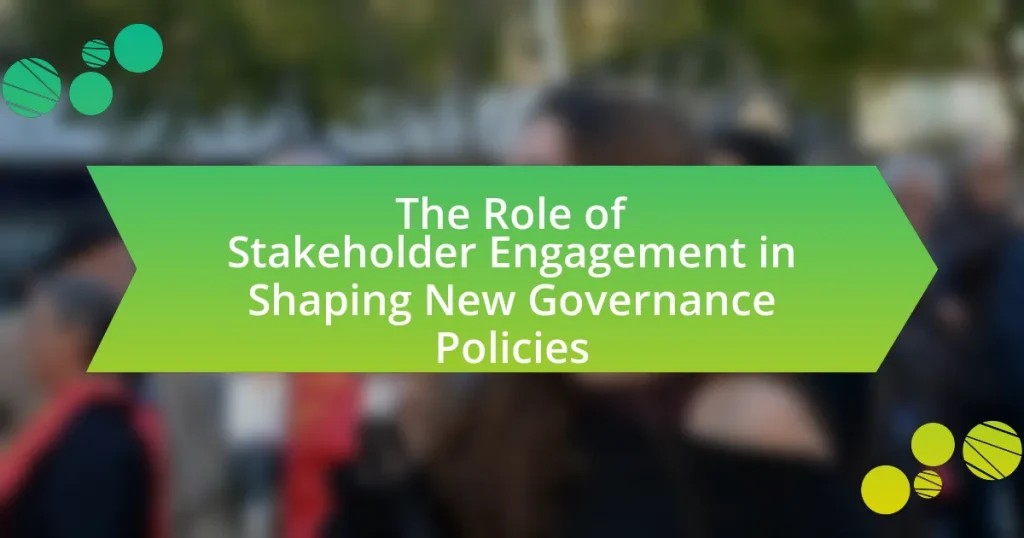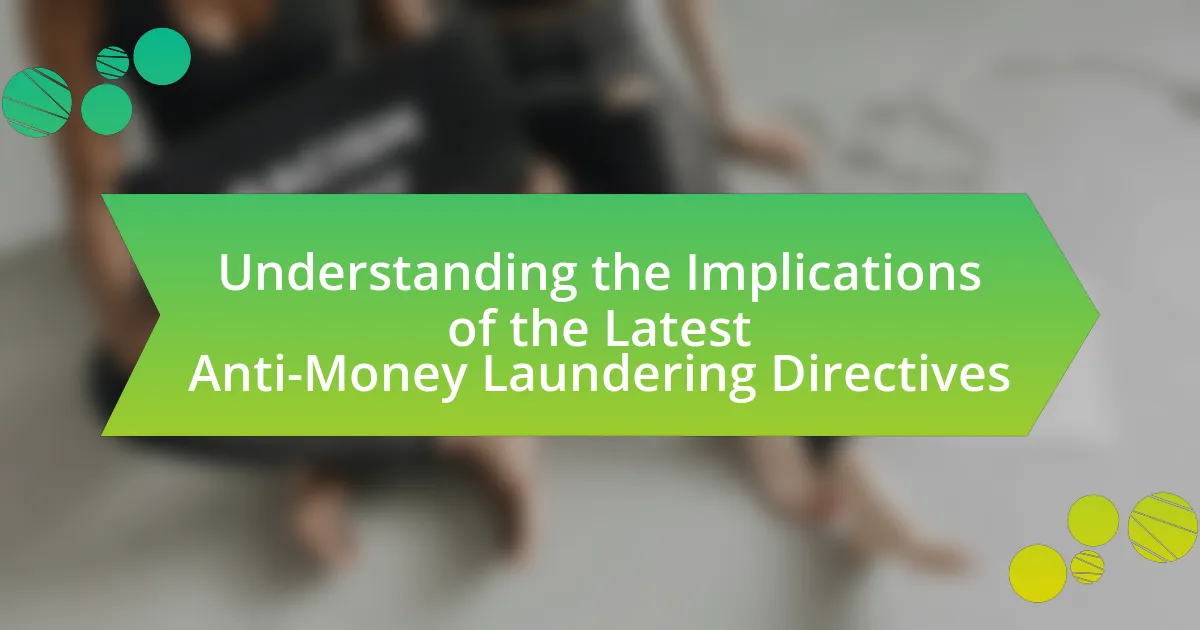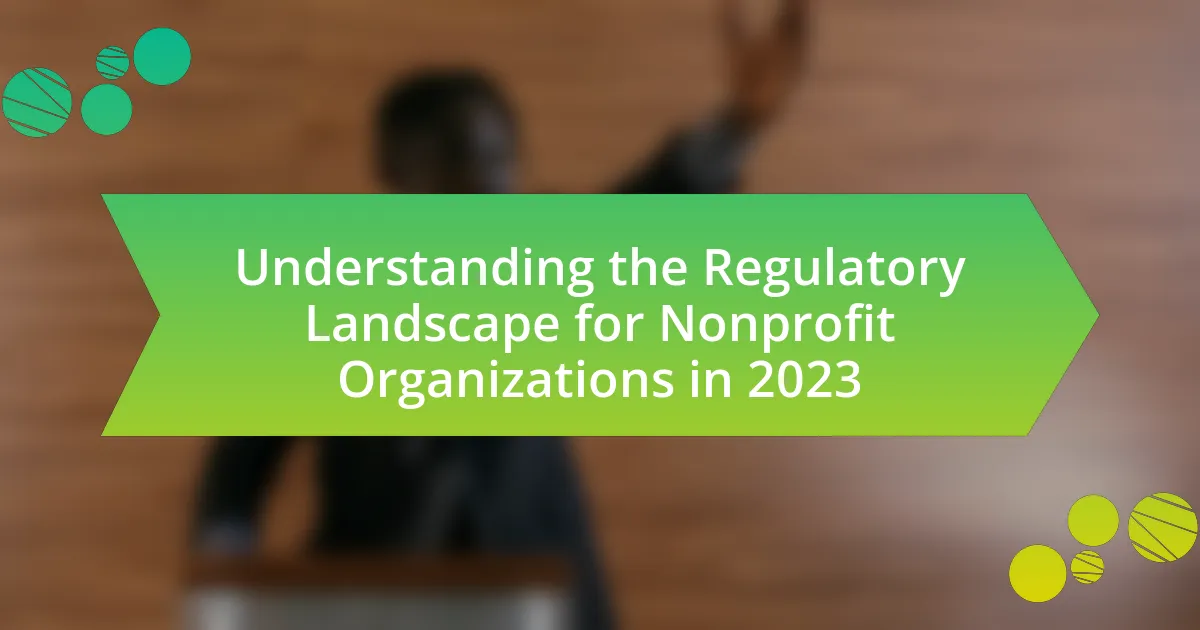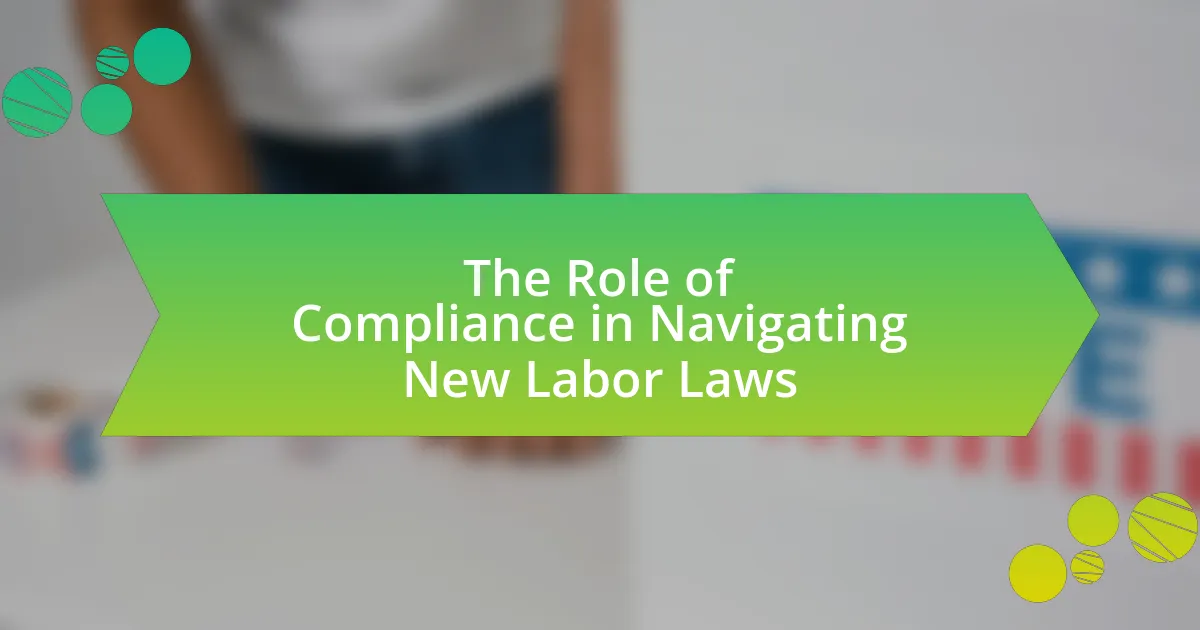Stakeholder engagement is a critical component in shaping new governance policies, as it ensures diverse perspectives and interests are integrated into decision-making processes. This article explores the influence of stakeholder engagement on policy development, highlighting its role in fostering transparency, trust, and legitimacy. Key elements of effective engagement, such as clear communication and collaboration, are discussed alongside various strategies for involving stakeholders. The article also examines the challenges faced in stakeholder participation, the impact of power dynamics, and best practices for enhancing inclusivity and effectiveness in governance. Ultimately, it underscores the importance of stakeholder perspectives in crafting policies that reflect community needs and values.
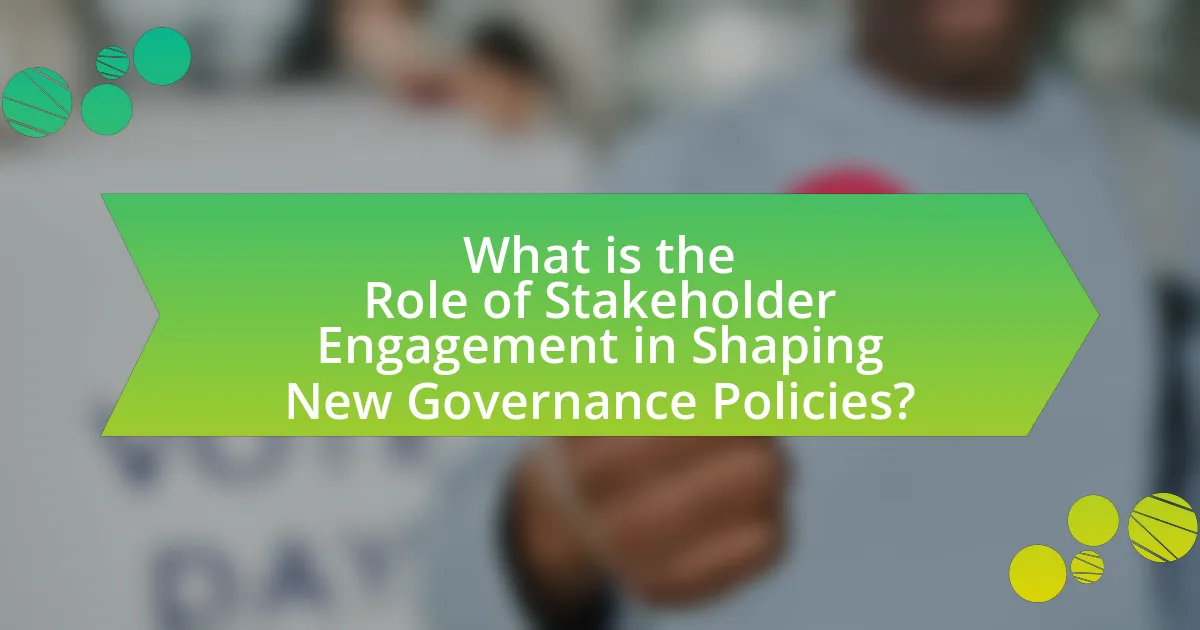
What is the Role of Stakeholder Engagement in Shaping New Governance Policies?
Stakeholder engagement plays a crucial role in shaping new governance policies by ensuring that diverse perspectives and interests are considered in the decision-making process. This engagement fosters transparency, builds trust, and enhances the legitimacy of policies, as stakeholders often possess valuable insights and expertise that can inform effective governance. Research indicates that inclusive stakeholder participation can lead to more sustainable and accepted policy outcomes, as seen in case studies where community involvement directly influenced environmental regulations, resulting in policies that better reflect the needs and values of the affected populations.
How does stakeholder engagement influence governance policy development?
Stakeholder engagement significantly influences governance policy development by ensuring that diverse perspectives and needs are considered in the decision-making process. This inclusive approach leads to more effective and equitable policies, as it allows policymakers to identify potential issues and opportunities that may not be apparent without stakeholder input. For instance, research conducted by the International Association for Public Participation highlights that engaging stakeholders can enhance the legitimacy and acceptance of policies, ultimately resulting in better implementation outcomes. By incorporating feedback from various stakeholders, governance frameworks can be tailored to address specific community concerns, thereby fostering trust and collaboration between the government and the public.
What are the key elements of effective stakeholder engagement?
The key elements of effective stakeholder engagement include clear communication, active listening, mutual respect, and collaboration. Clear communication ensures that stakeholders understand the objectives and processes involved, while active listening allows for the incorporation of stakeholder feedback into decision-making. Mutual respect fosters trust and encourages open dialogue, and collaboration enables stakeholders to work together towards common goals. Research indicates that organizations that prioritize these elements experience higher levels of stakeholder satisfaction and better project outcomes, as evidenced by a study published in the Journal of Business Ethics, which found that effective engagement practices lead to improved organizational performance and stakeholder relationships.
How do stakeholder perspectives shape policy outcomes?
Stakeholder perspectives significantly shape policy outcomes by influencing decision-making processes and priorities. When stakeholders, such as community members, businesses, and advocacy groups, express their views and needs, policymakers often adjust their strategies to align with these inputs. For instance, research by the International Association for Public Participation highlights that inclusive stakeholder engagement leads to more effective policies, as it ensures that diverse viewpoints are considered, ultimately resulting in solutions that better address the needs of the community. This alignment can enhance public trust and compliance, demonstrating that stakeholder perspectives are crucial in crafting policies that are both relevant and effective.
Why is stakeholder engagement essential in governance?
Stakeholder engagement is essential in governance because it fosters transparency, accountability, and inclusivity in decision-making processes. Engaging stakeholders ensures that diverse perspectives are considered, which leads to more informed and effective policies. Research indicates that inclusive governance practices enhance public trust and improve policy outcomes, as seen in the World Bank’s findings that stakeholder involvement can increase project success rates by up to 30%. This evidence underscores the critical role of stakeholder engagement in shaping governance policies that reflect the needs and interests of the community.
What benefits does stakeholder engagement provide to policymakers?
Stakeholder engagement provides policymakers with enhanced decision-making capabilities by incorporating diverse perspectives and expertise. This engagement leads to more informed policies that reflect the needs and values of the community, ultimately increasing public trust and support. Research indicates that policies developed with stakeholder input are more likely to be effective and sustainable, as they address real-world issues and garner broader acceptance among affected groups. For instance, a study by the International Association for Public Participation found that inclusive decision-making processes can improve policy outcomes by up to 30%, demonstrating the tangible benefits of stakeholder involvement in governance.
How does stakeholder engagement enhance transparency and accountability?
Stakeholder engagement enhances transparency and accountability by fostering open communication and collaboration between organizations and their stakeholders. This engagement allows stakeholders to voice their concerns, provide feedback, and participate in decision-making processes, which leads to more informed and inclusive governance. For instance, research by the International Association for Public Participation indicates that organizations that actively engage stakeholders are more likely to build trust and credibility, as stakeholders feel their input is valued and considered. This trust, in turn, promotes accountability, as organizations are held responsible for their actions and decisions in a transparent manner.
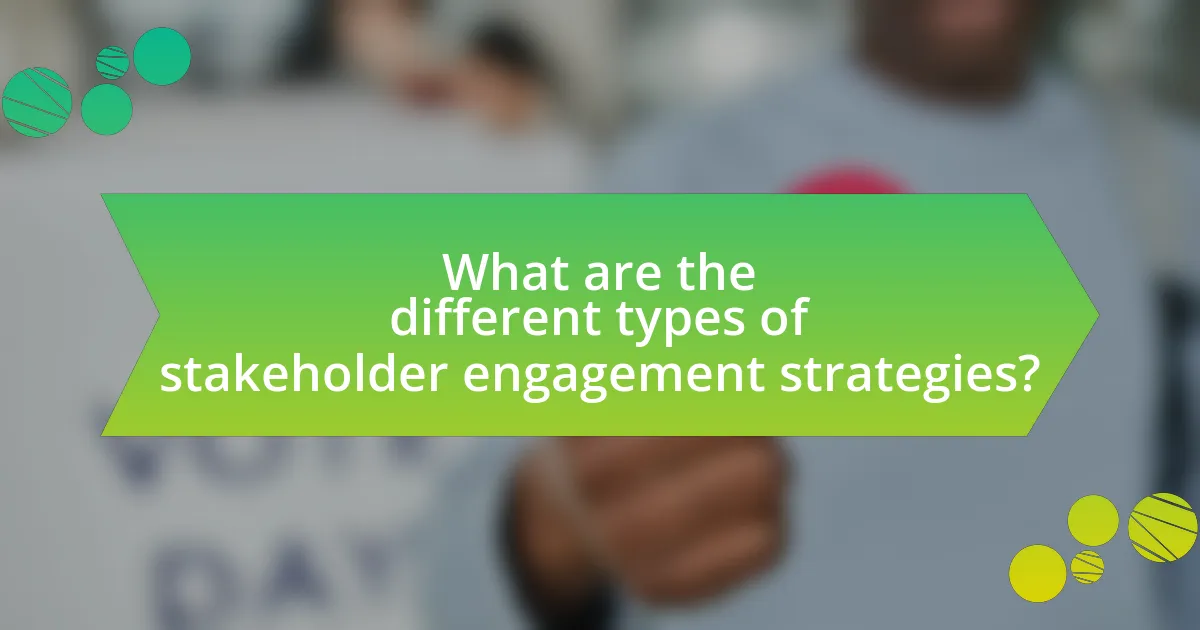
What are the different types of stakeholder engagement strategies?
The different types of stakeholder engagement strategies include informational, consultative, participatory, and collaborative approaches. Informational strategies focus on disseminating information to stakeholders, ensuring they are aware of relevant developments. Consultative strategies involve seeking feedback from stakeholders to inform decision-making processes. Participatory strategies encourage stakeholders to actively engage in discussions and contribute to shaping policies. Collaborative strategies foster partnerships between stakeholders and organizations, allowing for joint decision-making and shared responsibility. These strategies are essential in governance as they enhance transparency, build trust, and improve policy outcomes by incorporating diverse perspectives.
How can stakeholders be categorized in the governance process?
Stakeholders in the governance process can be categorized into four main groups: primary stakeholders, secondary stakeholders, key stakeholders, and peripheral stakeholders. Primary stakeholders are those directly affected by governance decisions, such as citizens and employees. Secondary stakeholders include groups that have an indirect interest, like NGOs and community organizations. Key stakeholders are influential individuals or groups that can significantly impact governance outcomes, such as government officials and business leaders. Peripheral stakeholders are those with a minimal or indirect interest in the governance process, such as academic institutions or media. This categorization helps in understanding the varying levels of influence and interest stakeholders have in governance, facilitating more effective engagement strategies.
What roles do different stakeholders play in policy formulation?
Different stakeholders play crucial roles in policy formulation by providing diverse perspectives, expertise, and resources. Government officials are responsible for drafting and implementing policies, while interest groups advocate for specific issues, influencing the agenda. Academia contributes research and analysis, offering evidence-based recommendations. The private sector provides insights on economic impacts and feasibility, while civil society organizations represent community interests, ensuring that policies address public needs. Each stakeholder’s involvement enhances the legitimacy and effectiveness of the policy-making process, as evidenced by the collaborative frameworks seen in successful governance initiatives worldwide.
How do stakeholder interests vary across sectors?
Stakeholder interests vary significantly across sectors due to differing priorities, regulatory environments, and economic impacts. For instance, in the healthcare sector, stakeholders such as patients prioritize quality of care and access to services, while pharmaceutical companies focus on profit margins and research funding. In contrast, the technology sector often sees stakeholders like consumers emphasizing innovation and data privacy, while investors are concerned with market share and return on investment. Additionally, the environmental sector highlights stakeholder interests in sustainability and conservation, which can conflict with industrial interests that prioritize production efficiency. These variations are influenced by sector-specific dynamics, such as regulatory frameworks, market conditions, and societal expectations, demonstrating that stakeholder engagement must be tailored to the unique context of each sector to effectively shape governance policies.
What methods are used for engaging stakeholders effectively?
Effective methods for engaging stakeholders include regular communication, participatory decision-making, and feedback mechanisms. Regular communication ensures stakeholders are informed about developments and can voice their opinions, fostering transparency. Participatory decision-making involves stakeholders in the planning and implementation processes, which enhances their commitment and ownership of outcomes. Feedback mechanisms, such as surveys and focus groups, allow stakeholders to express their views and influence future actions. Research indicates that organizations employing these methods experience higher stakeholder satisfaction and improved project outcomes, as evidenced by a study published in the Journal of Business Research, which highlights the correlation between stakeholder engagement practices and project success rates.
What are the advantages of participatory approaches in governance?
Participatory approaches in governance enhance decision-making by incorporating diverse stakeholder perspectives, leading to more inclusive and effective policies. These approaches foster transparency, as stakeholders are actively involved in the process, which builds trust between the government and the community. Additionally, participatory governance can improve policy outcomes by ensuring that the needs and preferences of various groups are considered, resulting in solutions that are more widely accepted and sustainable. Research indicates that participatory governance can lead to increased civic engagement, as seen in the case of participatory budgeting initiatives in cities like Porto Alegre, Brazil, where citizen involvement has led to more equitable resource allocation.
How can technology facilitate stakeholder engagement?
Technology can facilitate stakeholder engagement by providing platforms for real-time communication and collaboration. These platforms, such as social media, project management tools, and online forums, enable stakeholders to share their insights, feedback, and concerns efficiently. For instance, a study by the International Association for Public Participation found that 70% of organizations using digital tools for engagement reported improved stakeholder satisfaction. This demonstrates that technology not only enhances the speed of information exchange but also fosters a more inclusive environment where diverse perspectives can be considered in governance policy development.

What challenges exist in stakeholder engagement for governance policies?
Challenges in stakeholder engagement for governance policies include diverse interests, communication barriers, and power imbalances. Diverse interests among stakeholders can lead to conflicting priorities, making consensus difficult. Communication barriers arise from varying levels of understanding and access to information, which can hinder effective dialogue. Power imbalances often result in dominant voices overshadowing marginalized groups, limiting their input in the decision-making process. These challenges can impede the development of inclusive and effective governance policies, as evidenced by studies showing that stakeholder engagement is most successful when all voices are heard and considered.
What barriers hinder effective stakeholder participation?
Barriers that hinder effective stakeholder participation include lack of trust, inadequate communication, and limited resources. Lack of trust can stem from previous negative experiences or perceived power imbalances, which discourage stakeholders from engaging. Inadequate communication often results in stakeholders not being informed about processes or decisions, leading to disengagement. Limited resources, such as time and funding, can restrict stakeholders’ ability to participate fully in governance processes. These barriers are supported by research indicating that trust and communication are critical for successful stakeholder engagement, as highlighted in the study “Stakeholder Engagement: A Roadmap to Meaningful Engagement” by the International Association for Public Participation.
How can power dynamics affect stakeholder engagement?
Power dynamics significantly influence stakeholder engagement by determining the level of influence and authority different stakeholders hold in decision-making processes. When stakeholders possess varying degrees of power, those with greater influence can dominate discussions, shape agendas, and dictate outcomes, often sidelining less powerful voices. For instance, in governance contexts, powerful stakeholders may prioritize their interests over community needs, leading to disengagement from those with limited power. Research indicates that effective stakeholder engagement requires recognizing and addressing these power imbalances to foster inclusive participation, as highlighted in the study “Stakeholder Engagement: A Roadmap to Meaningful Engagement” by the International Association for Public Participation. This study emphasizes that equitable engagement strategies can mitigate the adverse effects of power dynamics, ensuring that all stakeholders have a voice in shaping governance policies.
What strategies can mitigate conflicts among stakeholders?
Effective strategies to mitigate conflicts among stakeholders include fostering open communication, establishing clear roles and responsibilities, and implementing collaborative decision-making processes. Open communication allows stakeholders to express their concerns and perspectives, which can lead to a better understanding of differing viewpoints. Establishing clear roles and responsibilities helps to minimize overlap and confusion, reducing potential friction. Collaborative decision-making processes, such as consensus-building workshops, encourage stakeholders to work together towards common goals, thereby enhancing cooperation and reducing conflict. Research indicates that organizations employing these strategies experience improved stakeholder satisfaction and reduced disputes, as evidenced by a study published in the Journal of Conflict Resolution, which found that effective communication and collaboration significantly decrease conflict occurrences in stakeholder interactions.
How can stakeholder engagement be evaluated for effectiveness?
Stakeholder engagement can be evaluated for effectiveness through measurable outcomes, feedback mechanisms, and alignment with project goals. Effective evaluation involves assessing the degree to which stakeholder input influences decision-making processes, which can be quantified through surveys, participation rates, and the implementation of stakeholder suggestions. For instance, a study by the International Association for Public Participation found that projects incorporating stakeholder feedback saw a 30% increase in community satisfaction and project success rates. This demonstrates that systematic evaluation of stakeholder engagement not only provides insights into its effectiveness but also enhances governance policies by ensuring they are responsive to the needs of the community.
What metrics can be used to assess stakeholder involvement?
Metrics used to assess stakeholder involvement include participation rates, feedback quality, stakeholder satisfaction surveys, and the frequency of communication. Participation rates measure the number of stakeholders actively engaged in discussions or activities, indicating their level of involvement. Feedback quality assesses the relevance and constructiveness of stakeholder contributions, which reflects their commitment and interest. Stakeholder satisfaction surveys gauge the perceptions and experiences of stakeholders regarding the engagement process, providing insights into their involvement. Lastly, the frequency of communication tracks how often stakeholders are updated or consulted, which can indicate the depth of their engagement in governance policies. These metrics collectively provide a comprehensive view of stakeholder involvement in shaping governance policies.
How can feedback from stakeholders improve future engagement efforts?
Feedback from stakeholders can significantly enhance future engagement efforts by providing insights into their needs and expectations. This input allows organizations to tailor their strategies, ensuring that communication and initiatives resonate with stakeholders. For instance, a study by the International Association for Public Participation found that organizations that actively incorporate stakeholder feedback see a 30% increase in engagement effectiveness. By analyzing this feedback, organizations can identify gaps in their current approaches and adjust their methods to foster stronger relationships and improve overall satisfaction.
What best practices should be followed for successful stakeholder engagement?
Successful stakeholder engagement requires clear communication, active listening, and inclusive participation. Clear communication ensures that stakeholders understand the goals and processes involved, while active listening allows for the identification of stakeholder concerns and needs. Inclusive participation fosters a sense of ownership and commitment among stakeholders, leading to more effective collaboration. Research indicates that organizations employing these practices experience higher satisfaction rates among stakeholders, which can enhance the overall effectiveness of governance policies. For instance, a study by the International Association for Public Participation found that projects with strong stakeholder engagement practices are 30% more likely to succeed in meeting their objectives.
How can policymakers ensure inclusivity in stakeholder engagement?
Policymakers can ensure inclusivity in stakeholder engagement by actively identifying and involving diverse groups in the decision-making process. This involves conducting outreach to underrepresented communities, utilizing various communication channels to reach different demographics, and creating platforms for open dialogue. Research indicates that inclusive stakeholder engagement leads to more equitable policy outcomes, as seen in the 2018 study by the International Association for Public Participation, which found that inclusive practices enhance trust and collaboration among stakeholders. By prioritizing inclusivity, policymakers can create governance policies that reflect the needs and perspectives of the entire community.
What role does communication play in effective stakeholder engagement?
Communication is essential for effective stakeholder engagement as it facilitates understanding, builds trust, and fosters collaboration among stakeholders. Clear and transparent communication ensures that stakeholders are informed about governance policies, their implications, and the decision-making processes involved. Research indicates that organizations with strong communication strategies experience higher levels of stakeholder satisfaction and engagement, leading to more successful policy outcomes. For instance, a study by the International Association for Public Participation found that effective communication significantly enhances stakeholder involvement and commitment to governance initiatives.
